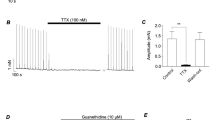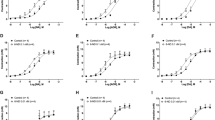Abstract
Intracellular recording techniques were used to monitor the resting membrane potential of smooth muscle cells and the excitatory junction potentials (EJPs) evoked by stimulation of the hypogastric nerve. Stimulation with trains of 15 pulses at 1 Hz or 0.33 Hz evoked individual EJPs which increased in amplitude from the first pulse and reached a plateau after 6–8 pulses. Stimulation at 1 Hz resulted in EJPs facilitating to a plateau level of approximately 25 mV, whereas with stimulation at 0.33 Hz the EJPs only facilitated to a plateau level of about 12 mV. With stimulation at 1 Hz, caffeine (3 mM and 10 mM), increased the amplitude of the first few EJPs in each train and decreased the extent of facilitation and reduced the amplitude of fully facilitated EJPs. In comparison, the amplitude of all EJPs evoked by stimulation at 0.33 Hz was increased by caffeine (3 mM and 10 mM). With 0.33 Hz stimulation, facilitation of the first few EJPs was observed in the presence of 3 mM caffeine but not in the presence of 10 mM caffeine. In the presence of the α2-adrenoceptor antagonist idazoxan, caffeine (3 mM and 10 mM) still enhanced the amplitude of EJPs early in trains of stimulation but there was no depression of EJPs later in the trains. Similarly, in reserpine-treated vasa deferentia, caffeine (3 mM) enhanced EJPs early in the train of stimulation at 1 Hz and there was no depression of EJPs at the end of the train. In addition to electrophysiological experiments, the effect of caffeine (0.1–30 mM) on the resting and stimulation-induced (S-I) efflux of radioactivity was investigated in guinea-pig isolated vasa deferentia previously incubated with [3H] -noradrenaline. Caffeine (10 mM) did not affect the resting efflux of [3H]-noradrenaline but significantly enhanced the S-I efflux by 150–160%. The present findings suggest that caffeine enhances sympathetic purinergic and noradrenergic transmission at the sympathetic neuroeffector junction in the guinea-pig vas deferens. Moreover, the increased release of transmitter noradrenaline can modulate purinergic transmission by activation of α2-adrenoceptors located at sympathetic neuroeffector sites.
Similar content being viewed by others
References
Alberts P, Bartfai T, Stjärne L (1981) Site(s) and ionic basis of α-autoinhibition and facilitation of [3H]-noradrenaline secretion in guinea-pig vas deferens. J Physiol (Lond) 312:297–334
Allcorn RJ, Cunnane TC, Kirkpatrick K (1986) Actions of α, β-methylene ATP and 6-hydroxydopamine on sympathetic neurotransmission in the vas deferens of the guinea-pig, rat and mouse: support for co-transmission. Br J Pharmacol 89:647–659
Alnaes E, Rahamimoff R (1975) On the role of mitochondria in transmitter release from motor nerve terminals. J Physiol (Lond) 248:285–306
Augustine GJ, Adler EM, Charlton MP, Hans M, Swandulla D, Zipser K (1992) Presynaptic calcium signals during neurotransmitter release: detection with fluorescent indicators and other calcium chelators. J Physiol (Paris) 86:129–134
Brock JA, Cunnane TC, Starke K, Wardell CF (1990) Alpha2-adrenoceptor mediated autoinhibition of sympathetic transmitter release in guinea-pig vas deferens studied by intracellular and focal extracellular recording of junction potentials and currents. Naunyn-Schmiedeberg's Arch Pharmacol 342:45–52
Burnstock G (1976) Do some nerve cells release more than one transmitter? Neuroscience 1:239–248
Burnstock G, Holman ME (1961) The transmission of excitation from autonomic nerve to smooth muscle. J Physiol (Lond) 155:115–133
Burnstock G, Holman ME (1962) Spontaneous potentials at sympathetic nerve endings in smooth muscle. J Physiol (Lond) 160:446–460
Cunnane TC (1984) The mechanism of neurotransmitter release from sympathetic nerves. Trends Neurosci 7:248–253
Friel DD, Tsien RW (1992) A caffeine- and ryanodine-sensitive Ca2+ store in bullfrog sympathetic neurones modulates effects of Ca2+ entry on [Ca2+]i. J Physiol (Lond) 450:217–246
Graefe KH, Stefano FJE, Langer SZ (1973) Preferential metabolism of (−)-[3H]-noradrenaline through the deaminated glycol in the rat vas deferens. Biochem Pharmacol 22:1147–1160
Illes P, Nörenberg W (1987) Electrophysiological evidence for an α2-adrenergic inhibitory control of transmitter release in the rabbit mesenteric artery. Eur J Pharmacol 143:151–161
James JE (1991) Pharmacology of caffeine. In: James JE (ed) Caffeine and health. Academic Press, London, pp 19–41
Katz B (1969) The release of neural transmitter substances. Liverpool University Press, Liverpool
Kupferman I(1991) Functional studies of cotransmission. Physiol Rev 71:683–732
Llinás RR (1991) Depolarization release coupling: an overview. Ann NY Acad Sci 635:3–17
Martinez-Serrano A, Satrústegui J (1989) Caffeine-sensitive calcium stores in presynaptic nerve endings: a physiological role? Biochem Biophys Res Commun 161:965–971
Nishimura M, Shimizu Y, Satoh E, Yokoyama T, Yagasaki O (1993) Factors influencing the twin-pulse facilitation of the release of transmitter at the mouse neuromuscular junction. Gen Pharmacol 24:1241–1247
Ramme D, Regenold JT, Starke K, Busse R, Illes P (1987) Identification of the neuroeffector transmitter in jejunal branches of the rabbit mesenteric artery. Naunyn-Schmiedeberg's Arch Pharmacol 336:267–273
Story DF McCulloch MW Rand MJ, Standford-Starr CA (1982) Conditions required for the inhibitory feedback loop in noradrenergic transmission. Nature 293:62–65
Thayer SA, Hirning LD, Miller RJ (1988) The role of caffeine-sensitive calcium stores in the regulation of the intracellular free calcium concentration in rat sympathetic neurons in vitro. Mol Pharmacol 34:664–673
Thesleff S (1986) Different kinds of acetylcholine release from motor nerve. Int Rev Neurobiol 28:59–88
Tóth PT, Török TL, Magyar K (1990) Depolarization promotes caffeine induced [3H]-noradrenaline release in calcium free solution from peripheral sympathetic nerves. Cell Calcium 11:557–583
Von Kügelgen I, Kurz K, Starke K (1994) P2-purinoceptor-mediated autoinhibition of sympathetic transmitter release in mouse and rat vas deferens. Naunyn-Schmiedeberg's Arch Pharmacol 349:125–132
Wakade TD, Bhave SV, Bhave A, Przywara DA, Wakade AR (1990) Ca2+ mobilized by caffeine from the inositol 1, 4, 5-triphosphate-insensitive pool of Ca2+ in somatic regions of sympathetic neurones does not evoke [3H] norepinephrine release. J Neurochem 55:1806–1809
Yamada Y, Nakazato Y, Ohga A (1989) The mode of action of caffeine on catecholamine release from perfused adrenal glands of cat. Br J Pharmacol 98:351–356
Ziogas J, Cunnane TC (1991) An electrophysiological study of the actions of angiotensin 11 at the sympathetic neuroeffector junction in the guinea-pig vas deferens. Br J Pharmacol 103:1196–1202
Author information
Authors and Affiliations
Rights and permissions
About this article
Cite this article
Ziogas, J., O'Farrell, M. & Slaughter, M. Caffeine enhances sympathetic purinergic and noradrenergic transmission in the guinea-pig isolated vas deferens. Naunyn-Schmiedeberg's Arch Pharmacol 352, 497–505 (1995). https://doi.org/10.1007/BF00169383
Received:
Accepted:
Issue Date:
DOI: https://doi.org/10.1007/BF00169383




